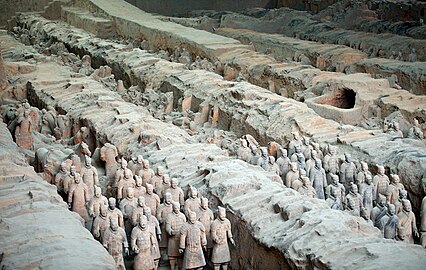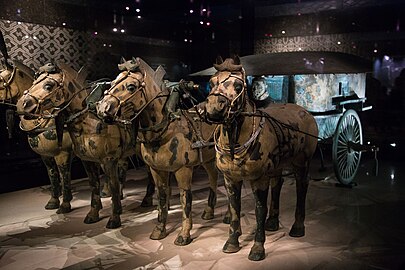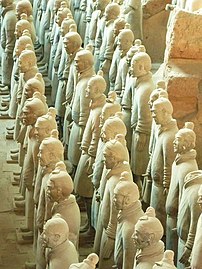
Terracotta Army
The Terracotta Army is a collection of terracotta sculptures depicting the armies of Qin Shi Huang, the first emperor of China. It is a form of funerary art buried with the emperor in 210–209 BCE with the purpose of protecting him in his afterlife.
For the historic complex, see Mausoleum of the First Qin Emperor.UNESCO World Heritage Site
Cultural: i, iii, iv, vi
1987 (11th Session)
兵马俑
Soldier and horse tomb-figurines
Bīngmǎ yǒng
Bīngmǎ yǒng
Ping1-ma3 yung3
Bīng-máah yúng
Bing1-maa5 jung2
Ping-bé ióng
The figures, dating from approximately the late 200s BCE,[1] were discovered in 1974 by local farmers in Lintong County, outside Xi'an, Shaanxi, China. The figures vary in height according to their rank, the tallest being the generals. The figures include warriors, chariots and horses. Estimates from 2007 were that the three pits containing the Terracotta Army hold more than 8,000 soldiers, 130 chariots with 520 horses, and 150 cavalry horses, the majority of which remain in situ in the pits near Qin Shi Huang's mausoleum.[2] Other, non-military terracotta figures have been found in other pits, including officials, acrobats, strongmen, and musicians.[3]
Scientific research
In 2007, scientists at Stanford University and the Advanced Light Source facility in Berkeley, California, reported that powder diffraction experiments combined with energy-dispersive X-ray spectroscopy and micro-X-ray fluorescence analysis showed that the process of producing terracotta figures colored with Chinese purple dye consisting of barium copper silicate was derived from the knowledge gained by Taoist alchemists in their attempts to synthesize jade ornaments.[77][78]
Since 2006, an international team of researchers at the UCL Institute of Archaeology have been using analytical chemistry techniques to uncover more details about the production techniques employed in the creation of the Terracotta Army. Using X-ray fluorescence spectrometry of 40,000 bronze arrowheads bundled in groups of 100, the researchers reported that the arrowheads within a single bundle formed a relatively tight cluster that was different from other bundles. In addition, the presence or absence of metallic impurities was consistent within bundles. Based on the arrows' chemical compositions, the researchers concluded that a cellular manufacturing system similar to the one used in a modern Toyota factory, as opposed to a continuous assembly line in the early days of the automobile industry, was employed.[79][80]
Grinding and polishing marks visible under a scanning electron microscope provide evidence for the earliest industrial use of lathes for polishing.[79]














